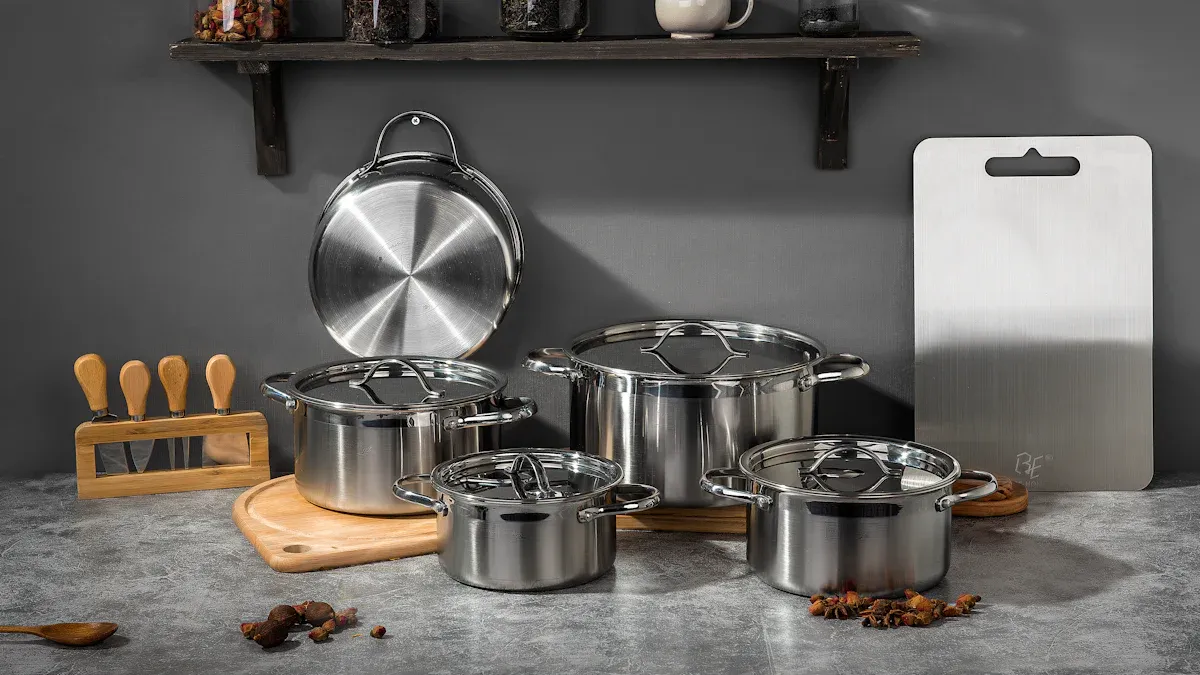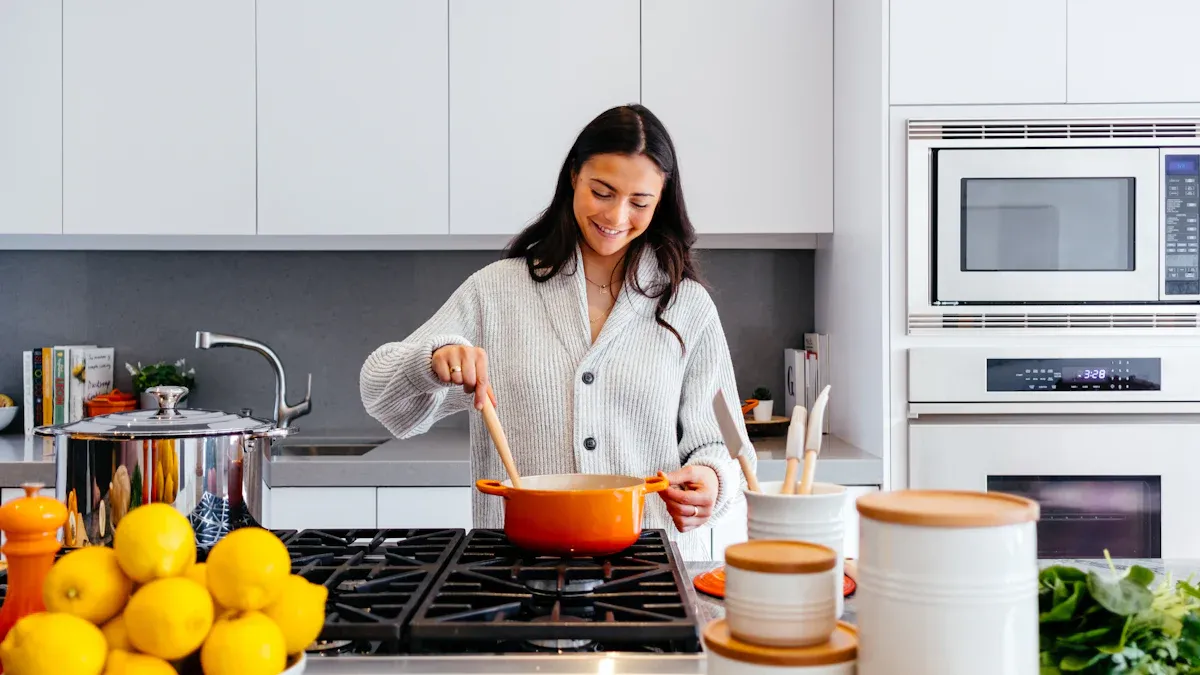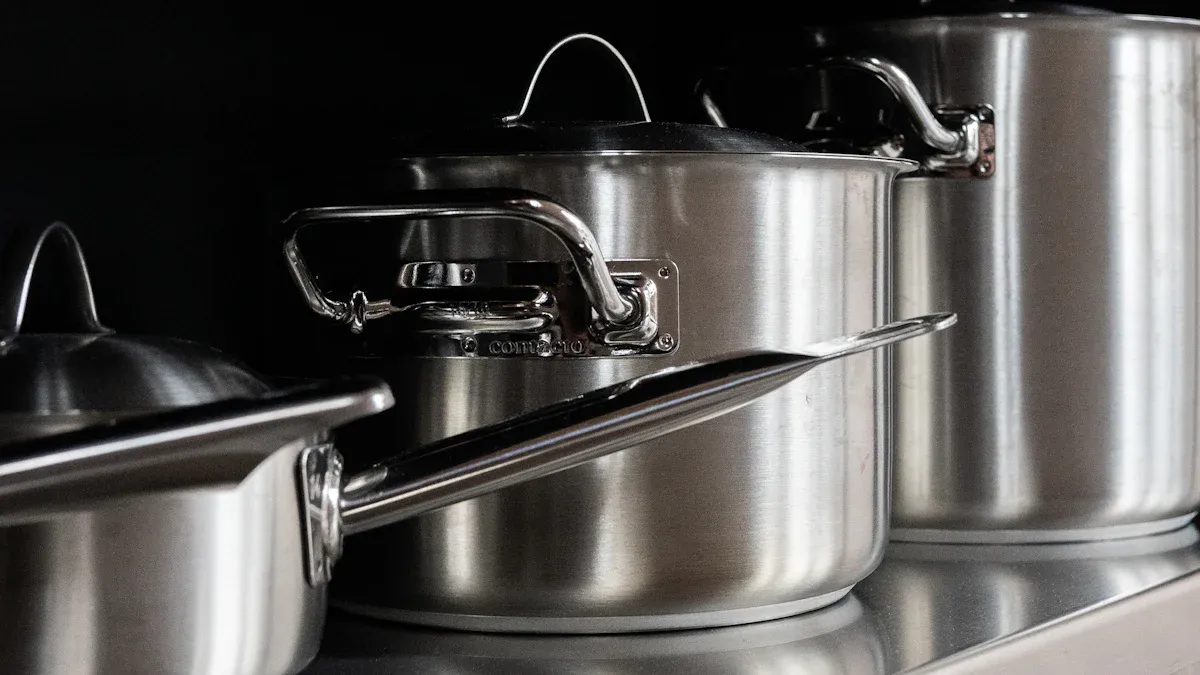
Using a die-cast aluminum pot correctly makes a big difference in your cooking experience. It helps you achieve the best flavors and textures in your meals. Plus, by taking care of your pot, you can extend its life and enjoy many delicious dishes. Remember, a well-maintained cookware handle is key to safe cooking!
Key Takeaways
- Use proper cooking techniques like sautéing, simmering, and braising to enhance flavors and textures in your meals.
- Manage heat effectively by starting low, using the right burner size, and avoiding high temperatures to prevent sticking and damage.
- Regularly inspect and clean your pot and its handle to ensure safety and longevity, using gentle methods to avoid scratches.
Using the Pot

Cooking Techniques
When you cook with a die-cast aluminum pot, you can explore various techniques to elevate your dishes. Here are some popular methods to try:
- Sautéing: This technique involves cooking food quickly in a small amount of oil over medium-high heat. It’s perfect for vegetables and proteins. Just remember to keep stirring to prevent sticking!
- Simmering: For soups and sauces, simmering is key. Bring your liquid to a gentle boil, then reduce the heat to let it bubble softly. This method helps flavors meld beautifully.
- Braising: If you want to cook tougher cuts of meat, braising is your friend. Start by searing the meat in the pot, then add liquid and cover. Let it cook slowly until tender.
Tip: Always preheat your pot before adding oil or food. This helps achieve a nice sear and prevents sticking.
Heat Management
Managing heat is crucial when using a die-cast aluminum pot. Here are some tips to help you get it right:
- Start Low, Go Slow: Begin with low to medium heat. Die-cast aluminum heats evenly and retains heat well, so you don’t need to crank up the temperature.
- Use the Right Burner Size: Match the size of your burner to the pot. A smaller pot on a large burner can lead to uneven cooking.
- Monitor Cooking Times: Keep an eye on your food. Since die-cast aluminum conducts heat efficiently, your meals may cook faster than expected.
- Avoid High Heat: High temperatures can cause food to stick and may damage the pot’s surface. Stick to medium heat for best results.
Note: If you notice any smoke, reduce the heat immediately. This will help prevent burning and keep your pot in great shape.
By mastering these cooking techniques and heat management tips, you’ll make the most of your die-cast aluminum pot. Happy cooking!
Cleaning the Pot
Recommended Cleaning Methods
Keeping your die-cast aluminum pot clean is essential for its longevity and performance. Here are some effective cleaning methods you can use:
- Hand Wash: Always hand wash your pot with warm, soapy water. Use a soft sponge or cloth to avoid scratching the surface.
- Baking Soda Paste: For tough stains, mix baking soda with a little water to create a paste. Apply it to the stained area, let it sit for a few minutes, then scrub gently.
- Vinegar Rinse: If you notice any lingering odors, rinse the pot with a mixture of equal parts vinegar and water. This helps neutralize smells and leaves your pot fresh.
Tip: Avoid using steel wool or abrasive cleaners. They can scratch the surface and ruin the pot’s finish.
Avoiding Damage
To keep your die-cast aluminum pot in top shape, follow these simple tips:
- Don’t Soak: Avoid soaking your pot for long periods. This can lead to discoloration and damage.
- Avoid High Heat: As mentioned earlier, high heat can warp the pot and affect its cooking performance. Stick to medium heat for best results.
- Store Carefully: When storing your pot, place a soft cloth or paper towel between it and other cookware. This prevents scratches and keeps it looking new.
By following these cleaning methods and damage prevention tips, you’ll ensure your die-cast aluminum pot remains a reliable kitchen companion for years to come! Happy cooking!
Maintaining the Cookware Handle

Regular Inspection
Taking care of your cookware handle is just as important as maintaining the pot itself. Regular inspections help you catch any issues before they become serious problems. Here’s what you should do:
- Check for Loose Screws: Every few uses, take a moment to check if the screws holding the handle are tight. If they feel loose, use a screwdriver to tighten them. This simple step can prevent accidents while cooking.
- Look for Cracks or Damage: Inspect the handle for any signs of wear and tear. Cracks can develop over time, especially if you frequently use high heat. If you notice any damage, consider replacing the handle to ensure safety.
- Test Stability: Give the handle a gentle shake to see if it feels secure. If it wobbles, it might need attention. A stable handle is crucial for safe cooking.
Tip: Make it a habit to inspect your cookware handle every time you clean your pot. This way, you’ll always stay on top of any potential issues.
Cleaning and Care Tips
Keeping your cookware handle clean is essential for both hygiene and longevity. Here are some tips to help you maintain it:
- Wipe Down After Each Use: After cooking, take a damp cloth and wipe down the handle. This removes any grease or food particles that may have splattered during cooking.
- Avoid Harsh Chemicals: When cleaning, steer clear of abrasive cleaners or harsh chemicals. These can damage the finish of the handle. Stick to mild soap and warm water for the best results.
- Dry Thoroughly: After washing, make sure to dry the handle completely. Moisture can lead to rust or corrosion, especially if your pot has metal components.
- Use a Soft Cloth: When cleaning, opt for a soft cloth or sponge. This prevents scratches and keeps the handle looking new.
Note: If your handle has a rubber or silicone grip, be extra gentle. These materials can wear out faster if scrubbed too hard.
By regularly inspecting and properly cleaning your cookware handle, you’ll ensure it remains safe and functional for years to come. Remember, a well-maintained handle contributes to a better cooking experience!
In summary, using your die-cast aluminum pot correctly enhances your cooking. Remember to manage heat, clean gently, and inspect handles regularly. By adopting these care practices, you’ll enjoy delicious meals and extend your pot’s life. Happy cooking!
Post time: Oct-08-2025
